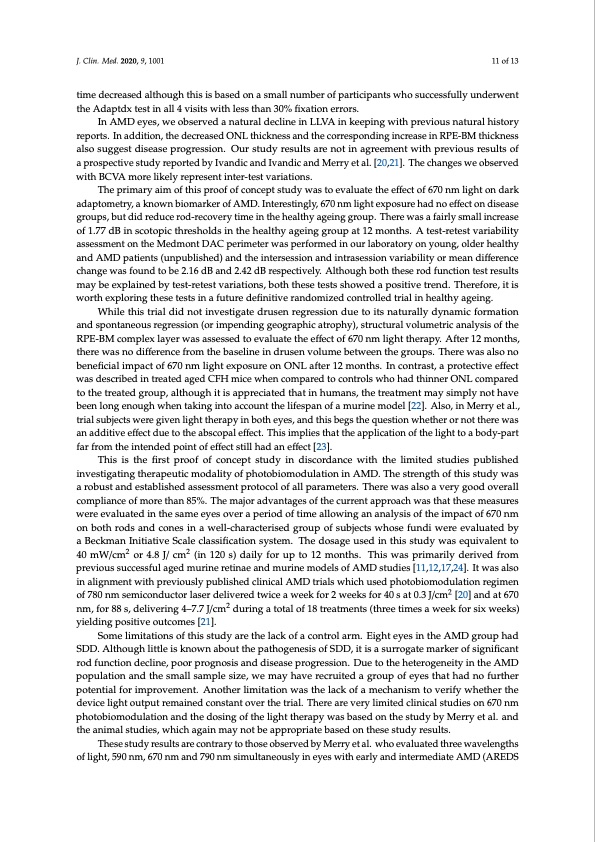
PDF Publication Title:
Text from PDF Page: 011
J. Clin. Med. 2020, 9, 1001 11 of 13 time decreased although this is based on a small number of participants who successfully underwent the Adaptdx test in all 4 visits with less than 30% fixation errors. In AMD eyes, we observed a natural decline in LLVA in keeping with previous natural history reports. In addition, the decreased ONL thickness and the corresponding increase in RPE-BM thickness also suggest disease progression. Our study results are not in agreement with previous results of a prospective study reported by Ivandic and Ivandic and Merry et al. [20,21]. The changes we observed with BCVA more likely represent inter-test variations. The primary aim of this proof of concept study was to evaluate the effect of 670 nm light on dark adaptometry, a known biomarker of AMD. Interestingly, 670 nm light exposure had no effect on disease groups, but did reduce rod-recovery time in the healthy ageing group. There was a fairly small increase of 1.77 dB in scotopic thresholds in the healthy ageing group at 12 months. A test-retest variability assessment on the Medmont DAC perimeter was performed in our laboratory on young, older healthy and AMD patients (unpublished) and the intersession and intrasession variability or mean difference change was found to be 2.16 dB and 2.42 dB respectively. Although both these rod function test results may be explained by test-retest variations, both these tests showed a positive trend. Therefore, it is worth exploring these tests in a future definitive randomized controlled trial in healthy ageing. While this trial did not investigate drusen regression due to its naturally dynamic formation and spontaneous regression (or impending geographic atrophy), structural volumetric analysis of the RPE-BM complex layer was assessed to evaluate the effect of 670 nm light therapy. After 12 months, there was no difference from the baseline in drusen volume between the groups. There was also no beneficial impact of 670 nm light exposure on ONL after 12 months. In contrast, a protective effect was described in treated aged CFH mice when compared to controls who had thinner ONL compared to the treated group, although it is appreciated that in humans, the treatment may simply not have been long enough when taking into account the lifespan of a murine model [22]. Also, in Merry et al., trial subjects were given light therapy in both eyes, and this begs the question whether or not there was an additive effect due to the abscopal effect. This implies that the application of the light to a body-part far from the intended point of effect still had an effect [23]. This is the first proof of concept study in discordance with the limited studies published investigating therapeutic modality of photobiomodulation in AMD. The strength of this study was a robust and established assessment protocol of all parameters. There was also a very good overall compliance of more than 85%. The major advantages of the current approach was that these measures were evaluated in the same eyes over a period of time allowing an analysis of the impact of 670 nm on both rods and cones in a well-characterised group of subjects whose fundi were evaluated by a Beckman Initiative Scale classification system. The dosage used in this study was equivalent to 40 mW/cm2 or 4.8 J/ cm2 (in 120 s) daily for up to 12 months. This was primarily derived from previous successful aged murine retinae and murine models of AMD studies [11,12,17,24]. It was also in alignment with previously published clinical AMD trials which used photobiomodulation regimen of 780 nm semiconductor laser delivered twice a week for 2 weeks for 40 s at 0.3 J/cm2 [20] and at 670 nm, for 88 s, delivering 4–7.7 J/cm2 during a total of 18 treatments (three times a week for six weeks) yielding positive outcomes [21]. Some limitations of this study are the lack of a control arm. Eight eyes in the AMD group had SDD. Although little is known about the pathogenesis of SDD, it is a surrogate marker of significant rod function decline, poor prognosis and disease progression. Due to the heterogeneity in the AMD population and the small sample size, we may have recruited a group of eyes that had no further potential for improvement. Another limitation was the lack of a mechanism to verify whether the device light output remained constant over the trial. There are very limited clinical studies on 670 nm photobiomodulation and the dosing of the light therapy was based on the study by Merry et al. and the animal studies, which again may not be appropriate based on these study results. These study results are contrary to those observed by Merry et al. who evaluated three wavelengths of light, 590 nm, 670 nm and 790 nm simultaneously in eyes with early and intermediate AMD (AREDSPDF Image | 670 nm Photobiomodulation in Age-Related Macular Degeneration

PDF Search Title:
670 nm Photobiomodulation in Age-Related Macular DegenerationOriginal File Name Searched:
jcm-09-01001-v2.pdfDIY PDF Search: Google It | Yahoo | Bing
Cruise Ship Reviews | Luxury Resort | Jet | Yacht | and Travel Tech More Info
Cruising Review Topics and Articles More Info
Software based on Filemaker for the travel industry More Info
The Burgenstock Resort: Reviews on CruisingReview website... More Info
Resort Reviews: World Class resorts... More Info
The Riffelalp Resort: Reviews on CruisingReview website... More Info
| CONTACT TEL: 608-238-6001 Email: greg@cruisingreview.com | RSS | AMP |